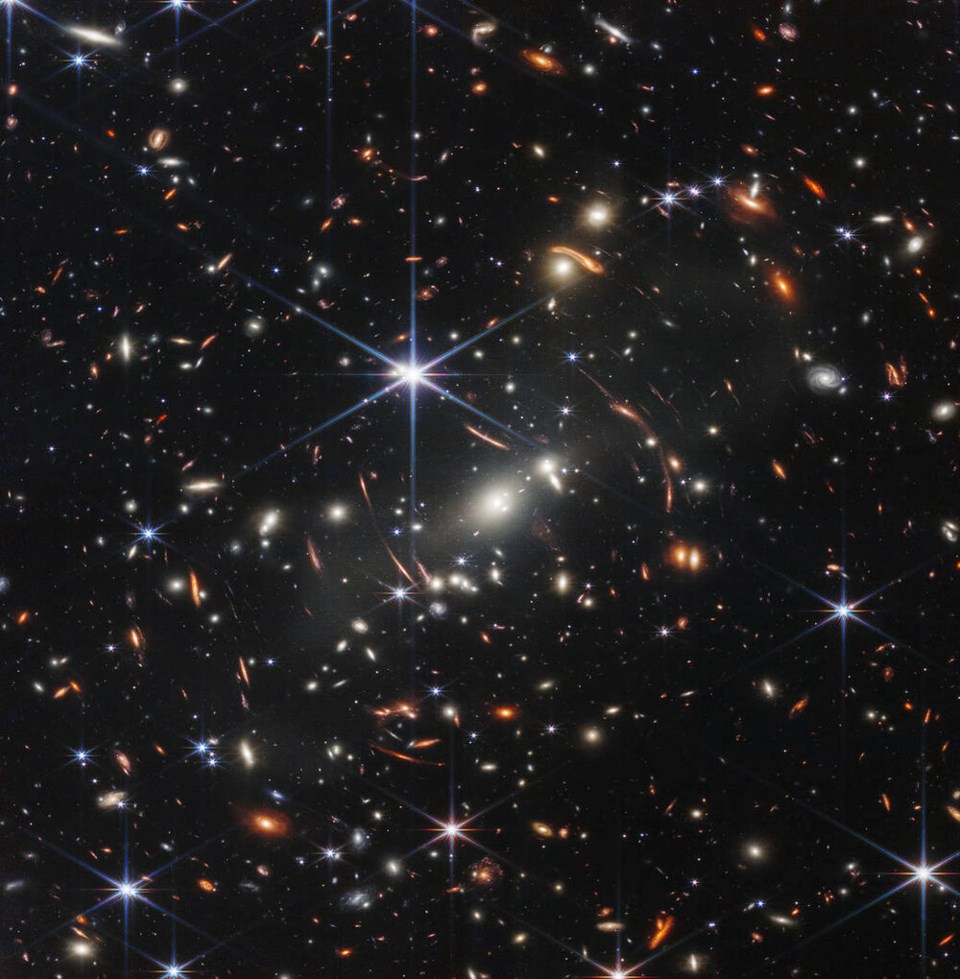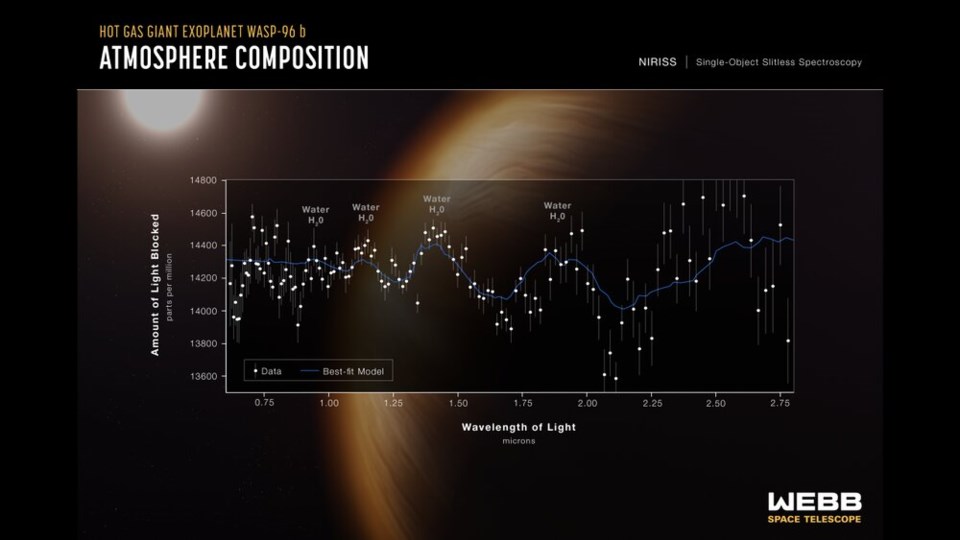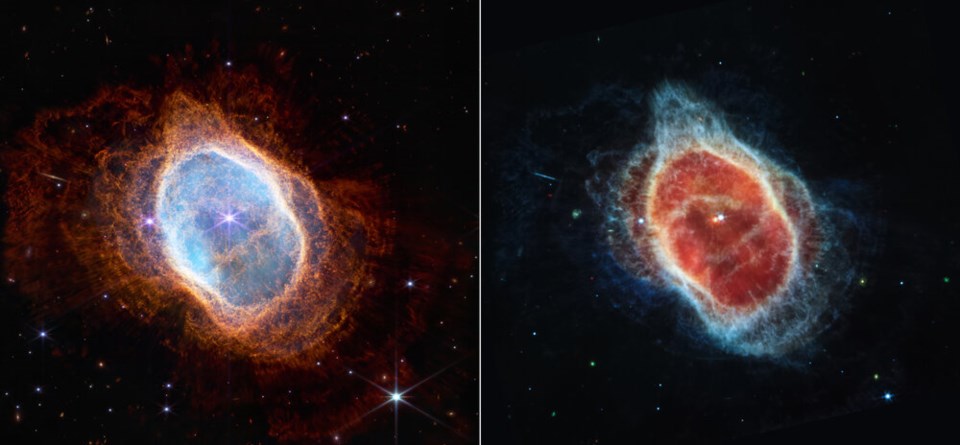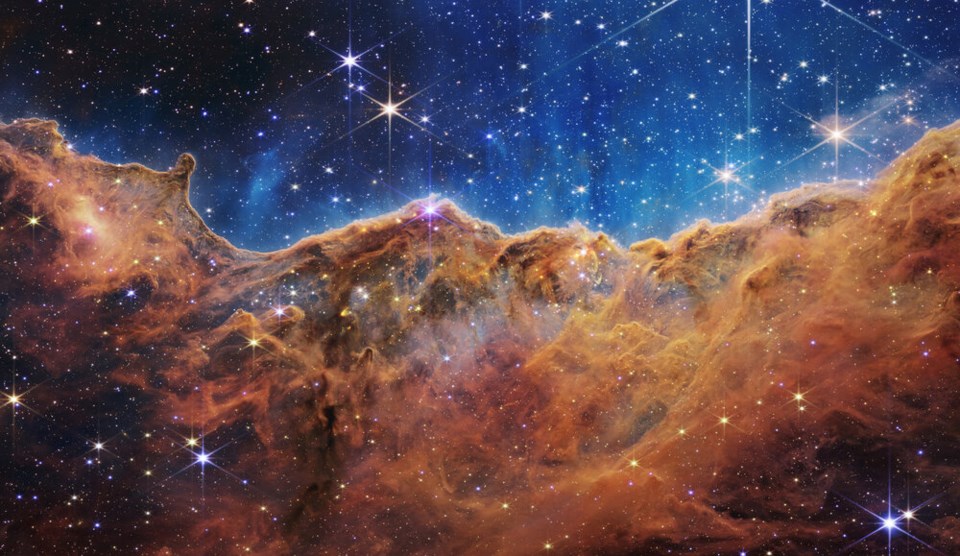Images from the world’s most powerful telescope humanity has ever created sent waves across the world Tuesday — in space centres and observatories where thousands held watch parties to private moments of wonder as four stunning portraits of deep space glanced across their mobile phones.
In a live broadcast on NASA TV, people gathered at observatories from Winnipeg to Perth, Australia, and were seen cheering after the release of the spectacular images.
Thanks to a new $10-billion James Webb Space Telescope — a joint project between the National Aeronautics and Space Association (NASA), 91ԭ�� Space Agency (CSA), European Space Agency (ESA) and the Space Telescope Science Institute — humanity has now caught the most detailed view of the early universe to date.
“Personally, I went and had an ugly cry... Because it works,” said astrophysicist Jane Rigby in a live broadcast.
Marley Leacock tuned into NASA TV at her grandparent's home in Calgary in what she described as one the biggest milestones in the history of scientific exploration.
“They grew up with the moon landing — that was already a far-fetched endeavour,” said the 91ԭ��-based H.R. MacMillan Space Centre astronomer. “To see galaxies that are like billions of years old, that is just a whole new world for them… how small we are and how far back we're able to see and how much more is out there.
“My grandparents could not have imagined it at all.”

A glimpse of a universe just born
The first public hint at what the powerful James Webb Space Telescope was capable of came a day earlier, when U.S. President Joe Biden revealed an infrared image looking back in time 4.6 billion years ago.
The telescope probed so deep into space that the powerful gravitational field of the galaxy cluster can be seen bending light rays from more distant galaxies, creating a warped centre.
The light from one galaxy in the image is thought to have travelled 13.1 billion years before the telescope’s mirrors captured it — a glimpse within a billion years of the Big Bang and the closest humans have ever got to seeing the beginning of the universe.
Galaxies with rich concentrations of stars and little dust appear blue; those with more dust and fewer stars are red; and galaxies dense with hydrocarbons and other chemicals show up as green.
NASA says such images will help researchers “understand how galaxies form, grow, and merge with each other, and in some cases why they stop forming stars altogether.”

Evidence of water on another planet
On Tuesday, more fantastic images emerged.
Using the 91ԭ��-built (NIRISS), readings from the puffy exoplanet 1,150 light-years away revealed temperatures over 500 degrees Celsius. The planet's high temperatures largely occur due to its orbit — it takes only 3.5 days to circle around its sun and it does so at a distance much closer than that of Mercury.
Known as WASP-96 b, the exoplanet is embedded in the southern-sky constellation Phoenix and is among 5,000 exoplanets known to exist in our galaxy.
It’s big, with a diameter 1.2 times that of Jupiter but with a mass half that of the local gas giant.
By pointing its instruments at the planet as it passes in front of its sun, researchers can measure how the light curves through at its edges, dimming starlight in different ways as it travels through atmospheric gases.
As NASA described it: “In the same way that people have distinctive fingerprints and DNA sequences, atoms and molecules have characteristic patterns of wavelengths that they absorb.”
On June 21, the telescope targeted the planet for over six hours. What emerged: evidence of clouds and the “unambiguous signature of water.”
To “read” the atmosphere of potentially habitable worlds, Leacock says following the water is the biggest and brightest clue.
“As far as we understand, life needs water to survive,” she said.
Even when water is absent, probing different atmospheres will give us a growing understanding of what other kinds of worlds exist in our universe.
Using its 270-square-foot gold-coated mirror, the telescope will collect and analyze infrared light from dozens of other exoplanets. Imagine small rocky planets and ice giants.
“Understanding how planets form and where and how they orbit around their stars and how they change their lives helps us to understand our own solar system,” said Leacock.
“And that feeds right into our search for life.”

The final act of a dying star
When these stars die, they don’t go out quietly.
In a second image of the Southern Ring planetary nebula, shells of gas and dust are pictured blasting from a binary set of stars.
Through a kaleidoscope of colours, the images reveal several distant galaxies in the background. One of the real surprises was the existence of a second star that was previously cloaked in dust.
At 2,500 light-years away, the two stars are locked in orbit around each other. Around them, each shell of gas and dust shows the remnants of a star losing part of its mass.
Over time, the nebula will enrich the area around it in an interstellar medium, and could form the soup for the creation of new stars or planets billions of years into the future, says NASA.
Leacock says a stellar death also marks the moment new elements emerge into existence. Getting a closer look at that process could help us understand how, when and under what circumstances the building blocks of physical creation come into being.
“There are only so many elements and they all have to come from somewhere,” said the astronomer.
“Carl Sagan said ‘we are all star stuff’ and this image really shows that.”

When galaxies collide
Known as “Stephan’s Quintet,” Webb’s largest image to date shows five galaxies colliding in the Pegasus constellation — a process that offers a hint of an early universe.
In capturing the inter-galactic dance, the composite image shows “huge shock waves” as galaxy NGC 7318B crashes through the cluster, in places triggering the formation of stars, says NASA.
After the Big Bang, the then-superheated universe was filled with similar tight galactic interactions. Over 13 billion years later, scientists have to look deeper into space to see such displays.
In the topmost galaxy, known as NGC 7319, a massive black hole 24 million times larger than our sun can be seen pulling in material while expelling the energy of 40 billion suns.
According to NASA, the new telescope will help researchers understand how such “supermassive black holes feed and grow.”
“If you ever want to satisfy your own curiosity, this is the image to do it,” said Leacock. “You have five galaxies, two of which are merging. You can see the gas and the stars in such detail.”
For Leacock’s mother, this was the most revelatory image, not because of the dance of galaxies in the foreground, but because of the points of light that shone through in the background — all galaxies of their own.
“For her, that was kind of her realizing that space isn't just flat,” she said.
But as an astronomer, Leacock was blown away by the detail of the supermassive black hole and the potential that such detailed imaging could teach humanity about galactic lifecycles.
One open question: When galaxies collide, will one sweep away the conditions required for star formation, or trigger a rejuvenation?
As Leacock puts it: “What happens when all of the stars go out?”
“We don't know entirely how galaxies end, or if they do, what their lives look like,” she added.
“This image will definitely help.”

'Cosmic Cliffs' show the birth of stars
The final image released by the three space agencies Tuesday shows so-called “stellar nursery” in the Carina Nebula 7,600 light-years away.
Almost like a glittering mountain range, the “Cosmic Cliffs” Webb captured show “peaks” up to seven light-years high. The upper edge of the nebula has been shaped by hot, young stars that blast stellar winds and ultraviolet radiation.
What appears to be steam radiating off the top of the nebula is actually hot dust pulling away from mass due to radiation. Hot dust and hydrocarbons on the surface of the ridges glow, “giving the appearance of jagged rocks,” according to NASA.
Through this kind of image, the telescope will help answer questions around what conditions set the stage for star birth and why stars form with a certain mass. It will also help scientists understand the evolution of the giant gas and dust clouds.
“Not only are some nebulae we see the end of a star, but some nebulae we see are also the cradles of the beginning of new ones,” said Leacock. “…finding that perfect balance is what this image can help us to understand.”
Telescope built to correct for damage
The telescope was built with the understanding it would face harsh ultraviolet light, charged particles from the sun and cosmic rays from exotic sources in the galaxy.
The only likely phenomenon standing in the telescope’s way are the unavoidable collisions with micrometeorites, often no bigger than a speck of dust but travelling at extreme velocities.
In early June, NASA said the James Webb Space Telescope sustained an impact to one of its primary mirror segments. Despite the damage to the mirrors, the telescope still exceeded all mission requirements as it was designed to withstand such bombardments.
That’s because the engineering team created a telescope with multiple mirrors that can be adjusted to correct for damage.
“We always knew that Webb would have to weather the space environment,” said Paul Geithner, technical deputy project manager at NASA’s Goddard Space Flight Center, in a statement at the time.
“We designed and built Webb with performance margin — optical, thermal, electrical, mechanical — to ensure it can perform its ambitious science mission even after many years in space.”
Reigniting a passion for space exploration
In her work at the H.R. MacMillan Space Centre in 91ԭ��, Leacock acts as a bridge between the stars, the people who study them and the public.
It’s a role that has been challenged in recent years as COVID-19 restrictions led to a drop in attendance at the space centre. Like many organizations, the space centre pivoted online, offering exploration and learning at the click of a mouse or tap of a screen.
Leacock and her colleagues are now moving back to in-person planetarium shows, interactive exhibits and the kind of learning that can do even more to inspire the next generation of space explorers.
“If you're new to space and learning about it, now you have a telescope that will provide discovery after discovery after discovery,” she said.
When she interacts with the public, the conversations always come back to Earth in some ways, back to questions around how the planet began and are there worlds like us out there?
Leacock expects the discoveries made over the James Webb Space Telescope's 20-year life will supercharge that curiosity and spark another revolution in our understanding of space.
“I don't think I really could have imagined how big it was going to be until I started to see the first engineering images coming out,” she said.
“And then I realized, like, OK, it's going to be big.”
